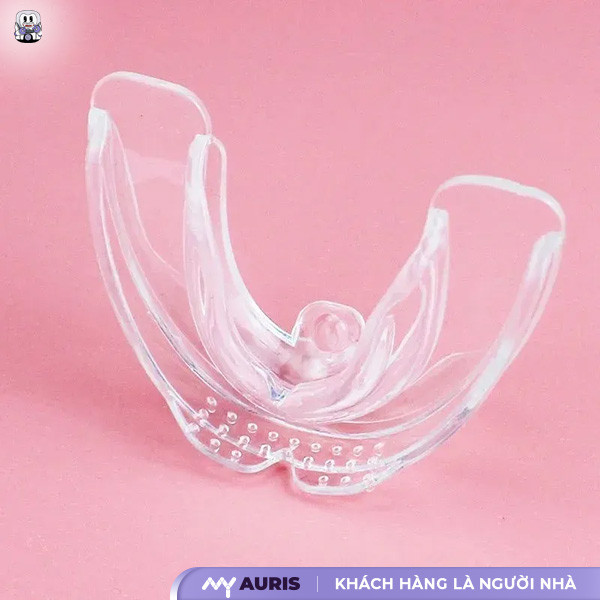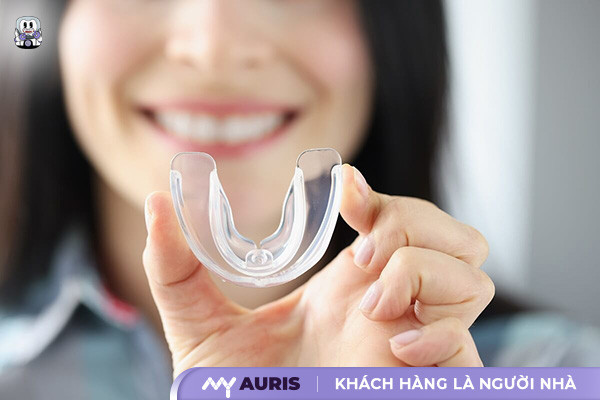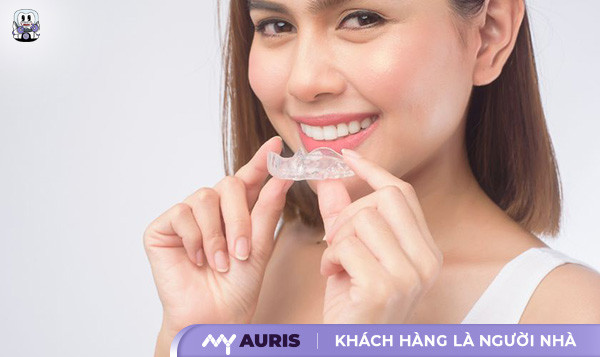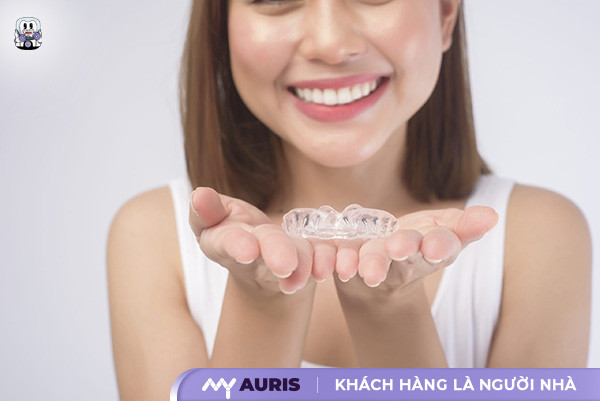You may not have heard of the concept of silicone braces, but in reality, this is another common name for a trainer appliance – an orthodontic device specifically designed for young children aged 5 to 10. The design of the trainer appliance facilitates early intervention, helping to correct minor dental misalignments and shape oral functional habits such as swallowing, breathing, and pronunciation. A clear understanding of silicone braces will provide parents with deeper insights to choose the appropriate solution for their child’s comprehensive oral development. In the following content, we – a team of experienced orthodontic specialists – will share scientific, updated, and reliable information surrounding this method.
What are Silicone Braces?
Silicone braces, also known as trainer braces, are modern orthodontic appliances specifically designed for children aged 5-10. This silicone bracing method is completely different from traditional bracket braces, archwires, and elastic bands. The innovation lies in the material: using non-thermal, flexible silicone or polyurethane, which offers high elasticity and good force resistance, making it very safe for children.
A key feature of silicone braces for children is their parabolic design that closely hugs the natural dental arch, making them suitable for various children’s arch sizes. This allows the device to easily fit snugly around the teeth, helping to align misaligned teeth and guide them back to their correct positions on the dental arch without the need for complex appliances.
As a preventive orthodontic method, silicone braces help prevent crooked teeth, crowded teeth, and teeth pushing against each other – issues commonly occurring during tooth development into adulthood. This is considered a safe and effective solution in pediatric dentistry, guiding jaw development and maintaining long-term oral aesthetics.

Common Types of Silicone Braces
Currently, two types of silicone braces commonly used in preventive orthodontics for children are blue silicone and pink silicone, each with distinct characteristics and uses, suitable for different stages of dental development.
Blue Silicone: This type is used in the initial stage of preventive orthodontics, helping to guide the eruption of incisors into alignment and ensure a correct bite. During treatment, children wear it for approximately 1 year, establishing a stable foundation for later dental arch development.
Pink Silicone: With a higher rigidity than the blue type, pink silicone braces have a stronger effect, particularly effective in intervening with misplaced teeth after wearing the blue appliance. The wearing time is approximately 1 year, but it can be adjusted depending on the child’s oral condition to ensure optimal effectiveness and long-term safety.

Are Silicone Braces Effective?
Silicone braces are currently a popular choice for many parents for their young children due to their effectiveness in correcting bad habits. When worn correctly, the silicone appliance effectively remedies children’s bad habits such as thumb sucking, nail biting, or tongue thrusting, which are common causes of dental misalignment. The appliance’s lightweight design, which snugly fits the dental arch, makes it very easy to use and comfortable for the wearer. Notably, the silicone material is safe, medical-grade, and poses no harm to the wearer’s health during long-term use. Provided it is used strictly according to a specialist’s instructions, this method can deliver noticeable orthodontic results, helping to shape well-aligned teeth from an early stage.

Should Adults Use Trainer Appliances?
One of the primary concerns for patients today is the effectiveness of using trainer appliances for adults to treat dental imperfections – especially in cases of overbite, underbite, or misalignment in the dental arch.
In reality, orthodontic treatment using silicone trainer appliances is generally ineffective for adults. This is because the corrective force of the product is too small, insufficient to impact the jawbone or teeth that have already developed and are fixed in adults. This is an important point that many still misunderstand.
Although silicone appliances designed for adults are thicker and more rigid than those for children, the force they exert is still negligible. This type of trainer appliance is only suitable when children have mild dental misalignments because at this stage, the jawbone is not yet fully developed and hardened, allowing silicone appliances to safely expand the dental arch.
For Which Cases Do Children Use Silicone Braces?
Silicone braces are suitable for children aged 5 to 10 and are recommended for early application to prevent common dental problems. Specifically, orthodontic treatment for 8-year-olds shows significant effectiveness, as after age 10, children may not achieve the desired results due to their more stable tooth structure. With high durability and good elasticity, silicone appliances help adjust teeth to the desired position, supporting parents in proactively caring for their children’s oral health from an early stage.
Silicone braces are often applied in cases such as:
Children with overbite (protruding teeth)
Crooked, misaligned teeth
Underbite, open bite, crossbite, deep bite
Beyond effective correction, silicone braces offer numerous outstanding advantages compared to fixed orthodontic appliances:
Faster correction of dental imperfections compared to fixed braces, saving treatment time
Eliminates bad habits in children such as thumb sucking, tongue thrusting, and teeth grinding – causes that negatively impact jaw development
Reduces pain and discomfort for children during use due to its flexible, soft, and friendly design.
Achieving the desired outcomes for parents, silicone braces are becoming a preferred choice for many families with young children. However, parents need to consider the appropriate age for application to choose a highly effective treatment method, helping their children develop healthy, beautiful teeth and full confidence.
When Should Silicone Trainer Braces Be Applied?
The suitable age for intervention with silicone trainer braces is typically between 5 and 10 years old – a golden developmental stage that helps shape stable jaw structures and supports more even teeth. During this period, if a child experiences malocclusion, early intervention yields long-term effectiveness and minimizes the need for complex bracing as an adult.
Common signs indicating that a child needs silicone brace intervention include:
- Crowded or misaligned teeth causing an unbalanced dental arch.
- Gaps between teeth, or teeth not fitting together tightly, reducing chewing function.
- Deep bite affecting aesthetics and easily creating pressure on the temporomandibular joint.
- Teeth erupting outwards or receding inwards, affecting pronunciation and appearance.
- Children with bad habits such as thumb sucking, mouth breathing during sleep, or prolonged pacifier use, which can distort natural jaw development.

Outstanding Advantages of Silicone Trainer Braces for Children Aged 5-10
Silicone braces are currently a groundbreaking orthodontic solution for children, particularly suitable for early intervention when dental misalignments are identified. Instead of waiting until an older age to apply methods like fixed braces or other orthodontic appliances, using silicone dental aligners helps reduce the longer time required for correction, supporting teeth to develop in the right direction from the outset.
Benefits of silicone dental aligners:
- Helps children’s teeth align properly and achieve a perfect bite, while creating a stable dental development framework, giving children a more beautiful smile from an early age.
- Effectively corrects teeth and curbs bad habits that cause dental arch deformation, such as tongue thrusting, thumb sucking, etc.
- Wearing silicone appliances is less painful, helping children avoid discomfort and irritation, thus leading to better cooperation during treatment.
- Particularly suitable for children aged 5-10, a golden stage for early intervention and effective guidance of maxillofacial development.
How Much Do Silicone Braces Cost?
Currently, many people wonder about the cost of silicone braces and whether they truly deliver the expected results. In reality, silicone braces do offer benefits – such as helping teeth erupt in alignment, supporting a more aesthetically pleasing face, and improving chewing function. However, this method is only effective when supervised by a specialist dentist.
According to market surveys, the current price for silicone braces ranges from 1,000,000 – 5,000,000 VND per set. However, many people end up buying products of unknown origin, silicone appliances of questionable quality, or those widely sold on the market without proper control over effectiveness and quality. This can easily lead to wasted money without achieving the desired results.
Failure to use the appliance according to a dentist’s instructions can lead to numerous problems such as affecting jawbone structure, dental inflammation, exposed tooth roots, prolonged pain, and even loose teeth. These consequences can also impact future tooth development, especially in children.





